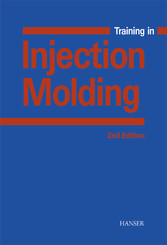Walter Michaeli, Helmut Greif, Gernot Kretzschmar, Frank Ehrig
Training in Injection Molding
A Text and Workbook
Foreword
6
Preface
8
Lessons
8
Key Questions
8
Prerequisite Knowledge
8
Review Questions
9
An Example: The Compact Disk (CD)
9
Appendices
9
Acknowledgments
9
Contents
10
Introduction Injection Molding – An Ideal Manufacturing Method
12
Key Questions
12
Contents
12
Injection Molding – A Young Production Method
13
Injection Molding – A Discontinuous Single-State Process
13
Injection Molding – The Injection Molding Machine and Mold
14
Lesson 1 Basic Principles of Plastics
16
Key Questions
16
Contents
16
1.1 Classification and Identification of Polymeric Materials (Plastics and Elastomers)
17
1.2 Deformation Characteristics of Plastics
19
1.3 Molding Compounds and Shaping Methods
22
1.4 Plastics Melts
23
1.4.1 Viscosity
23
1.4.2 Shear Stress and Shear Rate
24
1.4.3 Viscosity and Temperature
25
Review Questions
29
Lesson 2 The Injection Molding Machine
30
Key Questions
30
Contents
30
Prerequisite Knowledge
30
2.1 Classification of Injection Molding Machines
31
2.2 Structural Units of Injection Molding Machines
35
2.3 Special Injection Molding Processes
37
2.3.1 Structural Foam Molding
37
2.3.2 Multi-Injection Molding Process
38
2.3.3 Injection-Compression Molding
39
2.3.4 Back-Injection Technology
39
Review Questions
41
Lesson 3 The Plasticating and Injection Unit
42
Key Questions
42
Contents
42
Prerequisite Knowledge
42
3.1 Tasks of the Plasticating and Injection Unit
43
3.2 Plasticating
46
3.3 Injection
48
Review Questions
51
Lesson 4 The Mold
52
Key Questions
52
Contents
52
Prerequisite Knowledge
52
4.1 Tasks and Modes of Operation
53
4.2 Gating and Runner System
54
4.2.1 Basic Principles
54
4.2.2 Gate Design
55
4.3 Cavity
58
4.4 Heating/Cooling Systems
60
4.5 Ejection System
61
Review Questions
65
Lesson 5 The Clamping Unit
66
Key Questions
66
Contents
66
Prerequisite Knowledge
66
5.1 Function and Structure
67
5.2 Mechanical Clamping Units
68
5.3 Hydraulic Clamping Units
70
Review Questions
73
Lesson 6 Drive System and Controls
74
Key Questions
74
Contents
74
Prerequisite Knowledge
74
6.1 Drive System
75
6.1.1 Hydraulic Drive
75
6.1.2 Electric Drives
77
6.2 Controls
78
Review Questions
79
Lesson 7 The Injection Molding Process
80
Key Questions
80
Contents
80
Prerequisite Knowledge
80
7.1 Phases of an Injection Molding Cycle
81
7.2 Start
83
7.2.1 Mold and Clamping Unit
83
7.2.2 Plasticating Unit
83
7.2.3 Controls
83
7.2.4 Hydraulic- and Electrical Systems
84
7.3 Injection Phase
85
7.3.1 Mold and Clamping Unit
85
7.3.2 Plasticating Unit
85
7.3.3 Controls
86
7.3.4 Hydraulics
86
7.4 Holding Pressure Phase
88
7.4.1 Mold and Clamping Unit
89
7.4.2 Plasticating Unit
89
7.4.3 Controls
90
7.4.4 Hydraulics
90
7.4.5 Cooling Phase
90
7.4.6 Feed Phase
90
7.5 Cooling Phase
91
7.5.1 Cooling Time Equation
91
7.5.2 Mold and Clamping Unit
92
7.5.3 Plasticating Unit
92
7.5.4 Control and Hydraulic Systems
92
7.6 Feed Phase
93
7.6.1 Mold and Clamping Unit
94
7.6.2 Plasticating Unit
94
7.7 Removal from the Mold
94
7.7.1 Mold and Clamping Unit
95
7.7.2 Plasticating Unit
96
7.7.3 Hydraulics and Controls
96
Review Questions
97
Lesson 8 Mold Design
98
Key Questions
98
Contents
98
Prerequisite Knowledge
98
8.1 Tasks and Specifications of Injection Molding Tools
99
8.2 The Designer's Tasks
99
8.3 Mold Layout
101
8.3.1 Overview
101
8.3.2 Rheological Mold Layout
102
8.3.3 Thermal Mold Layout
105
8.3.4 Mechanical Mold Layout
106
Review Questions
109
Lesson 9 Quality Assurance in Injection Molding
110
Key Questions
110
Contents
110
Prerequisite Knowledge
110
9.1 Quality
111
9.2 Quality Assurance
112
9.3 Quality Management
113
9.3.1 The Quality Assurance Concept
115
9.4 Integrated Management Systems
119
Review Questions
121
Lesson 10 Recycling of Plastics Waste
122
Key Questions
122
Contents
122
Prerequisite Knowledge
122
10.1 Reutilization of Plastics
123
10.2 Recycling of Production Waste
126
10.3 Recycling ofIndustrial and Domestic Plastics Waste
127
Review Questions
129
Appendix I The Modem Injection Molding Company
130
Key Questions
130
Contents
130
Prerequisite Knowledge
130
I.1 Structure of an Injection Molding Company
131
I.2 Order Processing Organization within an Injection Molding Company
132
I.3 Specifications for Injection Molding Companies
133
Appendix II Occupational Safety Around Injection Molding Machines
135
Key Questions
135
Contents
135
II.1 European Regulations
136
II.1.1 Accident Prevention Regulations for Injection Molding Machines
136
II.1.2 Endangerment and Essential Danger Areas
136
II.1.3 Accident Prevention Regulation (APR) for Injection Molding Machines
138
II.1.4 Implementation Instructions for APR on Injection Molding Machines
138
II.2 U.S. Regulations
140
II.2.1 Safety Procedures
140
II.2.2 Safety Regulations and Information
142
Appendix III Selected Literature
144
Appendix IV Glossary of Injection Molding Technology
147
Answers to Review Questions
157
Lesson 1
157
Lesson 2
157
Lesson 3
157
Lesson 4
157
Lesson 5
158
Lesson 6
158
Lesson 7
158
Lesson 8
158
Lesson 9
158
Lesson 10
159
© 2009-2024 ciando GmbH
 Zu Hanser-Fachbuch.de
Zu Hanser-Fachbuch.de
 Warenkorb
Warenkorb
